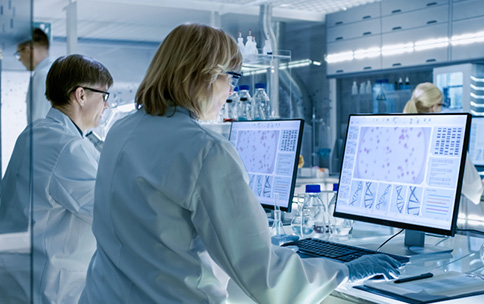
Although the disease breast cancer has one general name, the tumors that define it often contain different genetic mutations. In fact, a single tumor can have groups of cells with different mutations that arise naturally as a tumor grows or that occur after exposure to cancer treatments. This is important because certain mutations allow cancer cells to resist therapies and make the cancer more likely to recur. Dr. Christina Curtis, an NIH Director’s Pioneer Awardee, published two papers in Nature Communications and Nature where she applies computer modeling to genetic data from tumors and clinical follow-up data from patients to get a better understanding of the extent of genetic variability in breast cancer tumors before and after treatment.
In the first study, Dr. Curtis used computer models to investigate differences in genetic mutations between a tumor sample taken at diagnosis to one taken after surgery. Patients in this study had untreated tumors prior to surgery or received pre-surgery chemotherapy. Dr. Curtis’s computer modeling showed that genetic differences in breast cancer tumors may be present even before treatment, and in greater numbers than expected. Their data led them to suggest at least two areas of the same tumor should be sampled to accurately identify treatment-induced mutations. They also used the data to find evolutionary factors associated with tumor treatment-resistance, which could lead to better predictions of tumor behavior.
In the second report, Dr. Curtis and colleagues obtained data from over 3,000 breast cancer patients and used findings from her past research to group the cancer patients based on the molecular make-up of their tumors, including their genetic make-up. In doing this, she created the largest breast cancer cohort with both molecular characteristics and long-term follow up data to date. From this cohort, Dr. Curtis’s team discovered four groups of patient tumors that were prone to recurring later in life, up to 20 years after diagnosis. Collectively, these recurrent tumors made up about 26% of the tumors assessed. On the other end of the spectrum, they uncovered a group of breast cancers that rarely recur after five years. These molecular subtypes may help to improve predictions of late stage relapses beyond what is generally possible today, and someday guide treatment recommendations.
Reference
- Clonal replacement and heterogeneity in breast tumors treated with neoadjuvant HER2-targeted therapy. Caswell-Jin, J. L., McNamara, K., Reiter, J. G., Sun, R., Hu, Z., Ma, Z., Ding, J., Suarez, C. J., Tilk, S., Raghavendra, A., Forte, V., Chin, S-F., Bardwell, H., Provenzano, E., Caldas, C., Lang, J., West, R., Tripathy, D., Press, M. F., Curtis, C., Nature communications (2019) 565(7739), 361.
- Dynamics of breast-cancer relapse reveal late-recurring ER-positive genomic subgroups. Rueda, O. D., Sammut, S-J., Seoane, J. A., Suet-Feung, C., Caswell-Jin, J. L., Callari, M., Batra, R., Pereira, B., Bruna, A., Ali, H. R., Provenzano, E., Liu, B., Parisien, M., Gillett, C., McKinney, S., Green, A. R., Murphy, L., Purushotham, A., Ellis, I. O., Pharoah, P. D., Rueda, C., Aparicio, S., Caldas, C., & Curtis, C. Nature (2019).



